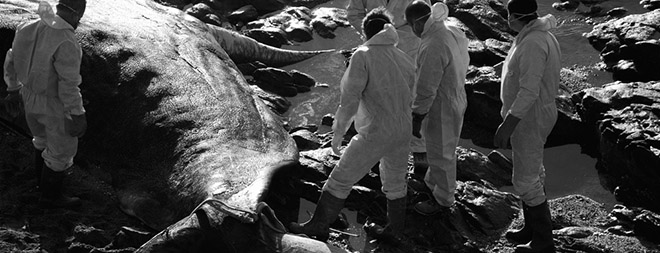A Belly Full Of Beaks

(ISNS)--Marine biologists, probing two rare species of sperm whales, are establishing a baseline for the health of the animals and the environment they live in by rummaging through the stomach contents of dead whales.
It will be a way of getting data on animals scientists know little about, and keeping track of environmental changes in the ocean.
Michelle Staudinger, now adjunct assistant professor of environmental conservation at the University of Massachusetts at Amherst, even sorted through specimens at the Smithsonian Institution for whales that died in the 19th century, although most of the specimens came from whales found dead on Atlantic beaches between 1998 and 2001.
Her research, done when she was at the University of North Carolina at Wilmington, is published in the journal Marine Mammal Science.
Sperm whales are toothed whales and eat almost nothing but ton-loads of squid, octopuses and some fish. Everything gets digested except the hard beaks of the squid and octopuses, which are made of chitin, a substance similar to fingernails. Staudinger said she has the unusual ability to identify the species of animal from just looking at the beaks collected during the necropsy, the animal equivalent of an autopsy.
“The whales accumulate hundreds and hundreds of beaks that knock against each other and chip away, but the primary way of getting rid of them is regurgitation,” she said. What she and her colleagues study are the ones still intact and rattling around when the whale dies.
Sperm whales are magnificent creatures known for containing the largest brain of any creature that ever lived on Earth. Their name comes from an organ located in the whale’s head that is filled with a mysterious substance called spermaceti. Whalers originally thought the substance had something to do with reproduction, hence the name, but it is now known that is not true. Ted Cranford, a researcher at San Diego State University has reported it has to do with echolocation, the ability of whales to broadcast sound waves to probe their environments. Another theory is that buoyancy is involved.
Get the world’s most fascinating discoveries delivered straight to your inbox.
Whatever it does, it gives sperm whales a huge, flat head.
Moby Dick, in Herman Melville’s novel of the same name, was a common sperm whale; unlike Melville’s creature, sperm whales in nature aren’t white. The mad, one-legged Capt. Ahab believed them to be evil but, while they are huge -- males can be 60 feet long -- they are totally benign. In reality, Moby Dick would just be a sperm whale, gorging itself on cephalopods and defending itself.
Staudinger concentrated on two rare species, dwarf sperm whales, and pigmy sperm whales, both of the genus Kogia. Pygmies can grow 11 feet long, dwarfs slightly smaller. There are believed to be fewer than 400 of the two species in the waters off the U.S. Atlantic coast, she said.
The two species are almost identical, she said, and even hard to tell apart in necropsies. The researchers had to do DNA analyses to separate pygmies from the dwarf whales.
First, they studied beached dead whales, 22 pygmies and nine dwarfs, all found on southern beaches. When they could not identify the kind of squid or octopus eaten by examining their beaks, Staudinger went to the Smithsonian to compare beaks with their collection.
She found a difference in their diets. Pygmy sperm whales had a more diverse diet than the dwarfs. That may mean they dive deeper for their food. If the environment changes, these whales could have a slight survival advantage.
The researchers then did analyses of the carbon and nitrogen in whale muscle samples and found that there seemed to be no difference in the overall habitats where the two species fed.
The experiment is similar to that done for fish and other marine animals, but this experiment provides the first such data on these rare species and comparisons between the two.
“We have very little data on these animals,” she said. “We are still learning basic information about them.”
It also provides a way of keeping track of their environment. If it changes, it would be seen in their diets.
“From a basic research standpoint, a description of diets is necessary to understand what resources the whales are using and where they are feeding. Once we have the information, we can learn about how the animals are responding to environmental changes like climate change, habitat and food resources,” she said.
If they go back in subsequent years they may be able to detect changes in the whales’ resources, she said.
The matter could be crucial because the two species may be in trouble, according to Charles Potter, collection manager for marine mammals at the Smithsonian Institution. While they are not officially endangered, biologists worry.
Scientists once thought the two species were the same until 1965 when it was found they were separate. At that time, there had been only 40 recorded sightings of the genus worldwide.
Currently, Potter says beached Kogia are the second-most likely whales to be stranded on the beaches of Florida. Scientists have no idea why, Potter said.
“Something is going on,” he said.
Inside Science News Service is supported by the American Institute of Physics. Joel Shurkin is a freelance writer based in Baltimore. He is the author of nine books on science and the history of science, and has taught science journalism at Stanford University, UC Santa Cruz and the University of Alaska Fairbanks. He tweets at @shurkin.


